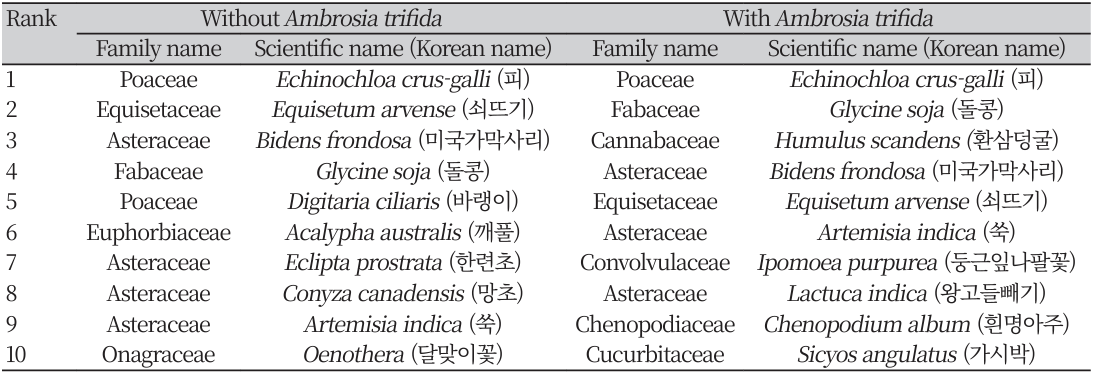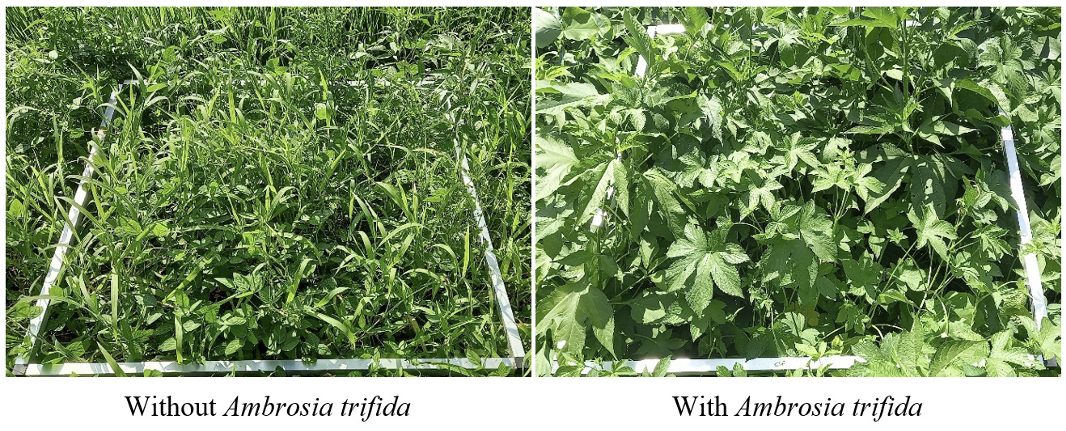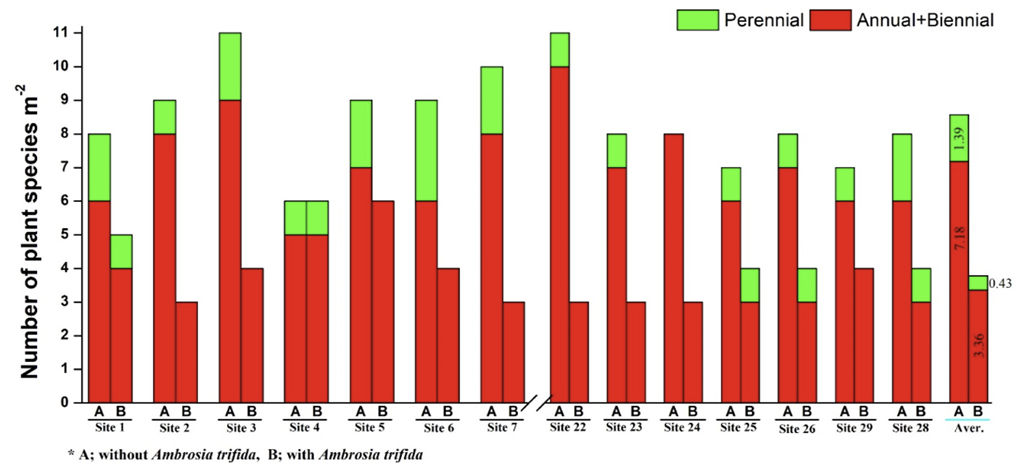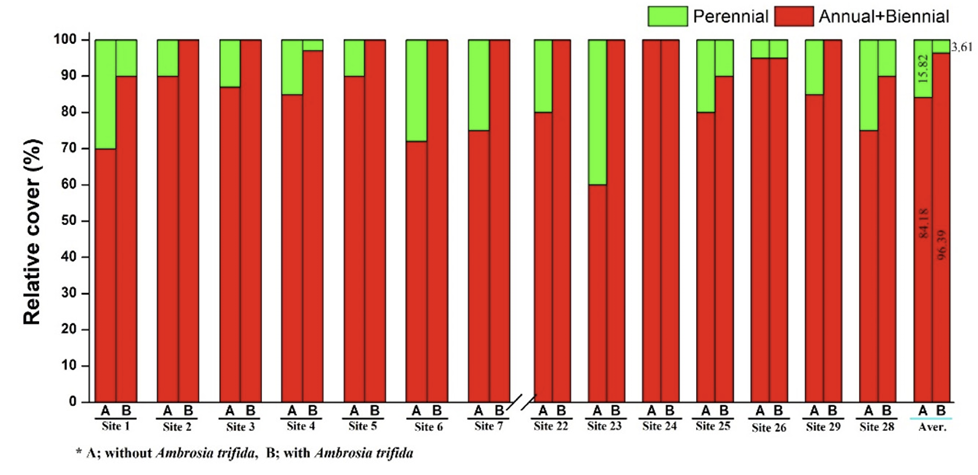Introduction
Non-native plants that are introduced into a new environment, intentionally or unintentionally, are known as alien plants. Most alien plant species do not pose a significant threat to the local ecosystem (Jung et al., 2017). However, some alien plants have a significant negative ecological impact on the surroundings, reduce biodiversity, and cause socioeconomic damage (Dogra et al., 2010; Pyšek et al., 2020; Son et al., 2021). Invasive alien plants (IAP) are especially troublesome as they disturb the balance of the ecosystem (Gallardo et al., 2019; Gentili et al., 2021; IUCN, 2000). They possess superior reproductive capabilities and can grow well in various environmental conditions, enabling them to spread rapidly and outcompete native species (Gioria & Osborne, 2014; Vilà et al., 2003).
In Korea, the accumulation of IAP species has increased; as of 2019, 375 taxa in total were documented (Son et al., 2019). These plants can be mainly found in industrial areas, paddy fields, uplands, orchards, riverside, pastures, and forest or reforested areas in Korea (Kim et al., 2018; Kim et al., 2020; Kim et al., 2017). The distribution of IAP is closely related to human activity. The number of IAP species is higher in the human-inhabited islands than in uninhabited ones (Kim et al., 2020). The distribution level of IAP in croplands is very similar to that of non-agricultural lands, which means that the ecological status of arable lands regarding the threats coming from IAP is similar to that of non-arable lands (Kim et al., 2017).
Ambrosia trifida, called giant ragweed, is an invasive annual species that causes significant harm to agricultural production, the ecosystem, and human health (Hamaoui-Laguel et al., 2015; Su et al., 2022) and is considered one of the most ecologically noxious weeds worldwide as well as in Korea (Bassett & Crompton, 1982; Kong et al., 2007). It is a highly invasive plant that dominates and suppresses plant communities (Abul-Fatih & Bazzaz, 1979) and is extremely challenging to control (Byun et al., 2020). This plant species dominates others through early germination, rapid vertical growth, and the formation of a tall, dense canopy (Abul-Fatih & Bazzaz, 1979). Ruziev et al. (2020) found that giant ragweed seeds can germinate during the cold months of spring regardless of the light period, which gives them a higher chance of propagation in early spring.
Rice is the main cultivated crop in Korea, with 727,158 ha in 2022 (Kwak, 2022). Rice field banks are the frame of the rice field and reserve the water. It also acts as a barrier to protect the rice fields from various weeds, insects, pests, or anything that comes from outside. The presence of IAP in rice field margins may make them form monospecific populations or dominate some habitats, which causes a significant loss in plant communities. As a result, the overall yield of rice may decrease, and major ecological problems may emerge. Since giant ragweed is one of the most distributed and noxious invasive alien species in Korea, it is crucial to assess the ecological impact (biodiversity issues) of this species on the banks of rice fields. Currently, there are no specific studies on the ecological impact of IAP on the bank of the paddy field in Korea or globally, except some studies that only focused on the distribution or vegetation traits of IAP in the paddy or other crop fields (Hwang et al., 2014; Kim et al., 2020) and the impact of IAP on rice field (Vagge & Chiaffarelli, 2023), not the bank of rice field. Therefore, this study aimed to fill this gap. The objectives of the present study were to assess the occurrence and distribution of A. trifida, one of the prominent representatives of IAP, and to estimate its impact on plant communities in the bank of rice fields.
Material and methods
Monitoring and data collection
The monitoring was carried out in paddy banks in major rice-cultivating areas across the country in August 2023. Quadrats measuring 1 m × 1 m were used for the survey to identify all plant species in each plot. Each site had five or more survey areas and f ive or more squares in each area. The identification process followed the guideline books by Lee et al. (2016) and Lee et al. (2017).
Data analyses
The relative cover (equation 1), relative density (equation 2), importance value (equation 3) of annual and perennial plant species, and the diversity index (equation 4) of plant communities were calculated in the presence (where A. trifida invades) and absence (the same area but A. trifida does not exist) of A. trifida. Global positioning system (Table 1) coordinators of each site were recorded, and the QGIS v3.24.0 program (QGIS, 2022), including Tile Map Service (TMS) for Korea, was used for mapping, and The World Geodetic System 1984 (WGS84) was used for the coordinate system. The graphs were created in the OriginPro 8.1 (OriginLab, 2021) program.
Ds = Diversity index; n = the total number of plants of particular species; N = The total number of all species.
Results and discussions
During the monitoring in 2023, A. trifida was found at 28 sites out of 118 sites, mainly in the northern parts of the country (Gangwon and Gyeonggi provinces) (Figure 1). Kim et al. (2017) also reported that giant ragweed is distributed intensively in northern Gyeonggi province, and is also found to be distributed in orchards and field crop cultivation areas in some southern regions. It was found that A. trifida covers 75.8 % of the land on average (Figure 1B). The relative coverage of A. trifida could reach 83.8% and 100% after four and six years after the invasion, respectively (Wang et al., 2022). Richardson et al. (2000) proposed that if the plant has a 50-80 % invasion character, the term ʻinvasive’ should be used without any inference to environmental or economic impact.
Echinochloa crus-galli was the most distributed species at the rice field bank in both the absence and presence of giant ragweed (Table 2). E. crus-galli is a highly invasive weed in various field crops, particularly rice (Bajwa et al., 2015), and despite the use of well-performing herbicides, weed genera, including Echinochloa species continue to dominate rice fields globally (Kraehmer et al., 2016). Equisetum arvense, Glycine soja, Artemisia indica, and Bidens frondosa are also found to be in both the absence and presence of giant ragweed (Table 2).
It can be seen in Figure 2 that giant ragweed highly dominates the plant communities and suppresses them. The number of weed species per square meter varied significantly depending on the presence or absence of giant ragweed. In the absence of giant ragweed, there were an average of 7.18 plants m-2 of annual weed species and 1.39 plants m-2 of perennial weed species. On the other hand, in the presence of giant ragweed, the number of annual weed species decreased to 3.36 plants m-2, and the number of perennial weed species increased to 0.43 plants m-2. We also found that the area with A. trifida had 22 distinct species of annual weeds and four different perennial weed species.
In contrast, the area where A. trifida was not present and had a significantly higher number of weed species, with 47 annual and seven perennial species being observed. Abul-Fatih and Bazzaz (1979) reported that, with A. trifida, the total standing above-ground plant biomass of the other species was 43.7 g m-2, their density was 86 plants m-2, and the species diversity (H) was 0.21. Without A. trifida, the corresponding values were 666 g m-2, 584 plants m-2, and 1.64.
Relative cover, relative density, and importance value of perennial plant species at the bank of rice fields were consistently lower in the presence of A. trifida than in the absence of A. trifida (Figures 3, 4, and 5). In other words, A. trifida negatively affected the relative cover, relative density, and importance value of perennial plant species. The average relative cover of the annual weed species was dominantly higher, with the dominance of 84.18% and 96.39% at the plot with and without A. trifida respectively (Figure 3). The relative density of annual weed species showed a similar pattern, 81.49% in the absence of A. trifida and 91.20% in the absence of A. trifida (Figure 4). The importance value of perennial species was 34.3 and 12.4 out of 200 in the absence and presence of A. trifida, respectively (Figure 5). Golmohammadi et al. (2018) also reported that the annual weed species were more dominant than the perennial ones in rice fields. In the present study, the Simpson’s diversity index (Ds) of weed species at rice banks in the absence and presence of A. trifida at the rice paddy banks was 0.83 and 0.61, respectively (Figure 6). The Ds value ranges from
zero to one. Zero represents no diversity, and one is infinite diversity. The bigger the value of Ds, the higher the diversity (Guiasu & Guiasu, 2014; Simpson, 1949). Peet (1974) explains that the phenomenon of low species diversity can be attributed to an area being dominated by only a few types of species. On the other hand, in a community with high species diversity, there is a high degree of complexity due to the interaction between a large number of species.
Conclusions
The study evaluated the effect of A. trifida, an alien weed, on the vegetation of paddy banks in Korea. The A. trifida was found in 28 out of 118 sites, mainly in the country's northern provinces. The presence of A. trifida negatively impacted the diversity of surrounding plant species on the bank of the rice field. The average relative cover of A. trifida was 75.8%, and the number of annual and perennial weed species per square meter was significantly lower in the presence of A. trifida. The diversity index was also lower in the presence of A. trifida. The dominance of A. trifida in the bank of rice fields causes a decrease in biodiversity, and perennial weeds may be affected the most. The ecological and water reserve potential of the paddy bank would be at risk due to A. trifida.











